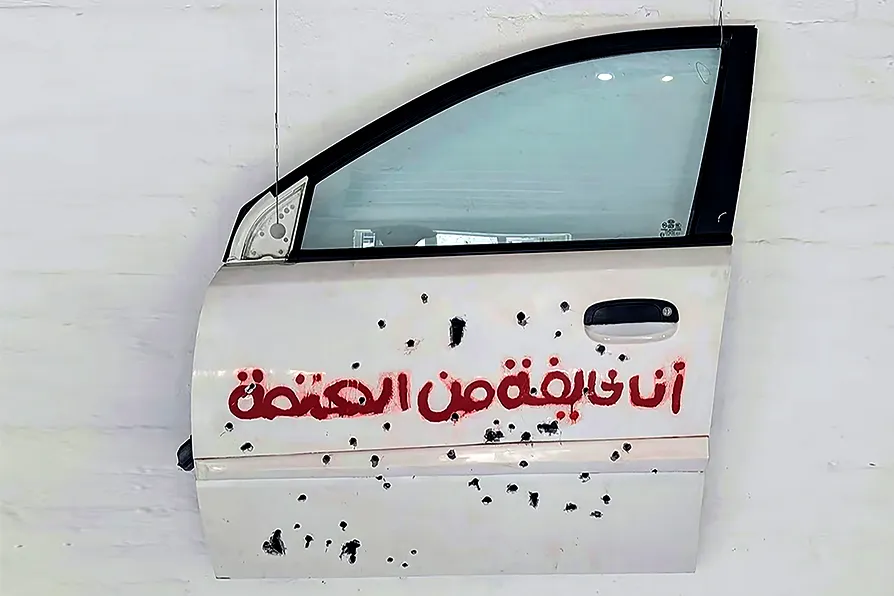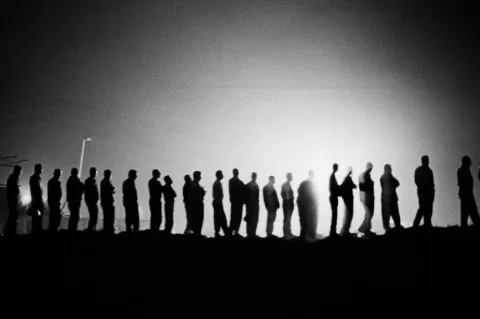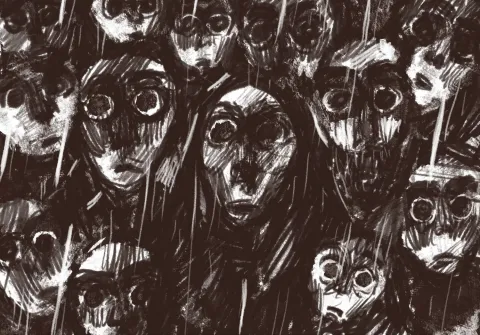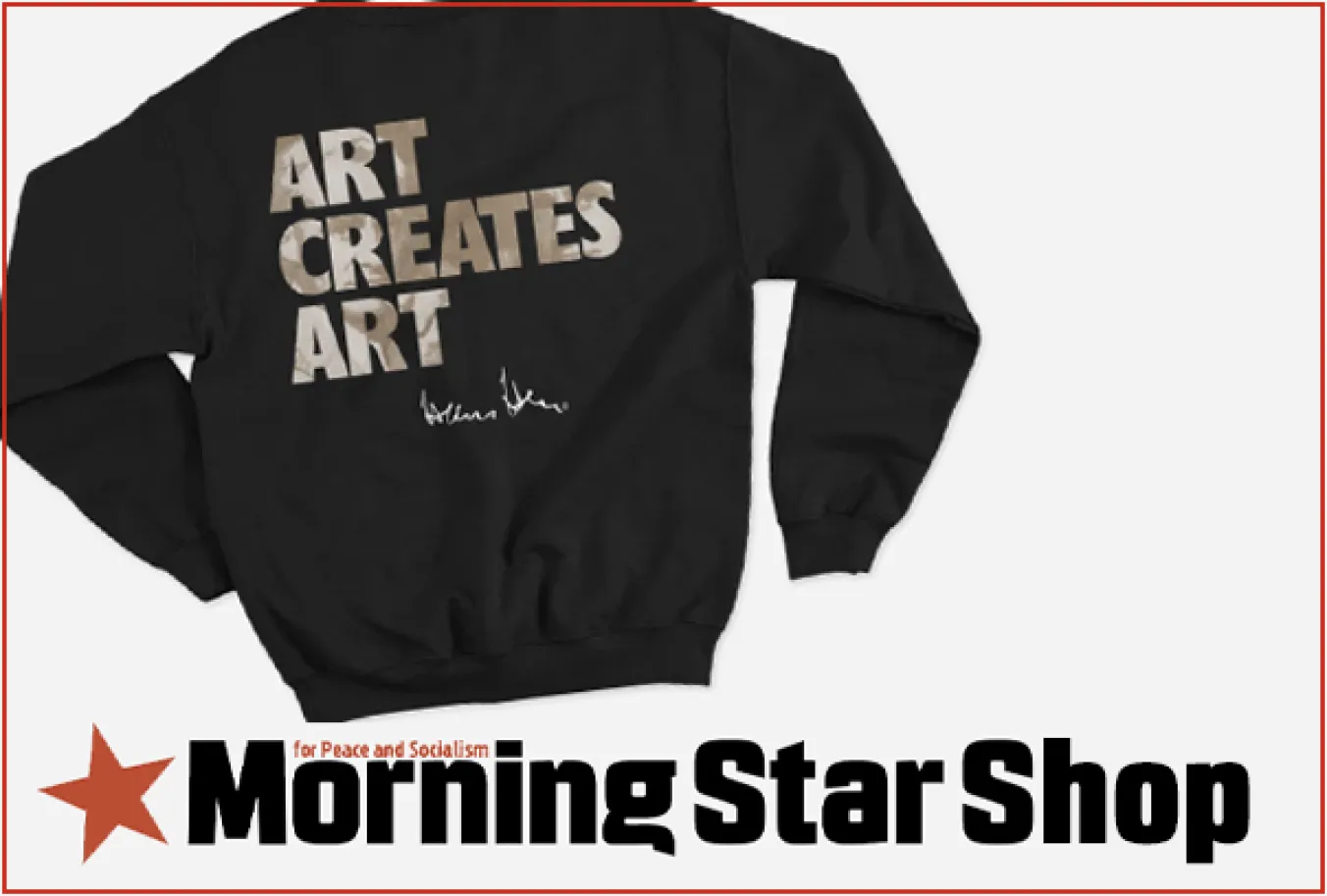ANDY HEDGECOCK and MARIA DUARTE review Good Night, and Good Luck: Live from Broadway, Becoming Victoria Wood, Hamnet, and Song Sung Blue
JOHN GREEN is stirred by an ambitious art project that explores solidarity and the shared memory of occupation

 I’m Afraid of the Dark, by Council Baby and Spicebag [Pic: Daragh Drake]
I’m Afraid of the Dark, by Council Baby and Spicebag [Pic: Daragh Drake]
Dluthphairtiocht
Metamorphika Studio,
★★★★★
DLUTHPHAIRTIOCHT (the Irish word for solidarity), an exhibition of art works expressing solidarity with Palestine, is a form of direct action. It also offers a way that you can interact, learn, and contribute financially to the project, with all profits being donated to Dignity for Palestinians, a charity run by UNRWA doctor Musallam Abukhalil, on the ground in central Gaza.
The exhibition aims to highlight and strengthen the historical links between Ireland and Palestine as well as revealing contemporary responses to what is unfolding in the occupied territories.
It is little wonder that the Republic of Ireland has consistently supported solidarity actions with other peoples struggling for liberation. Their own suffering at the hands of their British colonisers has been instrumental in forging that consciousness. As one of the artists says: “Occupation is buried deep in our psyche.”
This exhibition is an excellent example of that solidarity. It highlights the shared experience of occupation and the brutal suppression of human rights as well as the resistance common to both the Irish and Palestinian peoples. It brings together photos, drawings, paintings, collages and posters.
There are few graphic images of the occupation itself, the bombing, shattered apartments, the maimed and the murdered. This exhibition attempts to hold our attention and win our understanding through more subtle means.
As you enter the gallery, you are immediately confronted by the works of the acclaimed Irish photographer Seamus Murphy. Though he’s spent over three decades documenting war and migration across the globe, it is his time in Gaza and the West Bank in the mid-2000s that has stayed with him.

One photograph, grainy and dim, captures a group of men among barbed wire fencing, staring down at a checkpoint. “It was five in the morning on a Sunday,” Murphy recalls. “I walked with them from their towns, they prayed on the way, before they queued at the crossing. Some were allowed into Israel for work. Many were turned back.
“You cannot escape it, when you cross into Israel from Gaza, the contrast is extraordinary: you have unbelievable social chaos and poverty … and then manicured roads and advanced technology. It’s a vivid image of how people are treated under occupation.”
Co-curator Sean Og O Murchu describes the show as “the world’s largest international exhibition of contemporary Irish artists” – while providing a safe haven for the work of Palestinian artists living in exile.
Among those featured is Nabil Abughanima, who left Gaza two months ago and now lives in France. “Before the most recent war,” he says, “I gathered a team of young artists and began building what we hoped would be Gaza’s first independent animation studio. I rented a space, equipped it and watched the dream take its first real form.”
Named Al-Sununu (The Swallow), the war devastated his investment, leaving it in ruins, along with his home and his family’s house, both of which were brutally destroyed by the occupation.

His charcoal drawing depicts empty eye-sockets staring at us. They remind the viewer of gas-masks, or perhaps African tribal masks. They stare at the viewer, neither accusingly or beseechingly, but demanding that we acknowledge their existence. This is a Gazan’s view of the world.
Flying People is a dreamlike pen and ink sketch by Palestinian artist Amal Al Nakhala who was forced to move from Gaza with her family to relative safety in Cairo. The piece shows people in the sky, upside down, suspended over jagged teeth and clawing hands. Al Nakhala says she “played with symbolism, where the people on the ground become the war planes,” flipping the world on its axis.
Her work is not a literal depiction of the war, she says, but an attempt to capture its absurd repetition: “It shows how occupation becomes the norm, and death becomes normalised.”
Another exhibit hits you in the guts: a car door riddled with bullet holes. Across it, scrawled in Arabic, are the words “I’m afraid of the dark”. It is a collaboration between Irish artist Spicebag and Scottish artist Council Baby, a stark tribute to five-year-old Hind Rajab, killed by Israeli forces in January 2024 after being stranded in Gaza City in a car with her family. For hours, she pleaded for help over the phone while family members and paramedics lay dead beside her. An investigation found the car she was in had 335 bullet holes in it.
“She stands out,” says Spicebag. “Among so many faceless dead children, there’s a common touch point there, with the emergency call and the desperation in her voice. It’s visceral and horrifying.”
But this exhibition isn’t just symbolic, or a passive act of watching from afar. All proceeds go to Dignity for Palestinians, a charity founded by Dr Musallam Abukhalil which provides food, water and nappies to displaced families in Gaza. “The money might go to a food basket, clean water, maybe something small for a camp,” Abukhalil says. “It’s that direct. Art is resistance in Gaza, it always has been.”
Dluthphairtiocht is at Metamorphika Studio, London until July 19, and then on tour to Cork, Dublin and Belfast. For more information see: dluthphairtiocht.com
On July 17, 18.00 - 23.00, Metamorfika are hosting A Sonic Evening of Solidarity with artist and curator Lottie Mac

JAN WOOLF examines work that aims to give viewers a material experience of the environments in the polar north and Britain equally affected by the climate crisis

MIKE QUILLE applauds an excellent example of cultural democracy: making artworks which are a relevant, integral part of working-class lives

BLANE SAVAGE recommends the display of nine previously unseen works by the Glaswegian artist, novelist and playwright

SYLVIA HIKINS casts an eye across the contemporary art brought to a city founded on colonialism and empire










